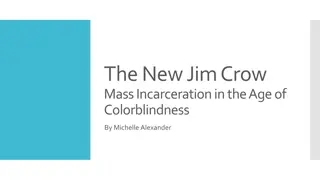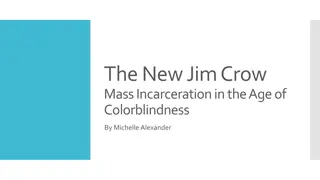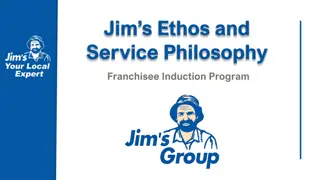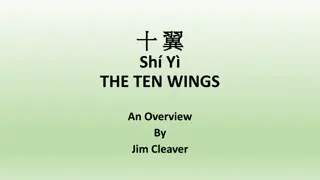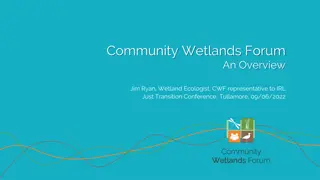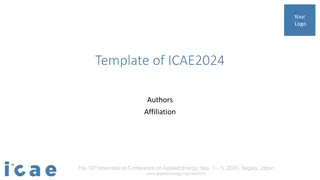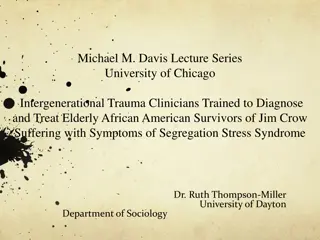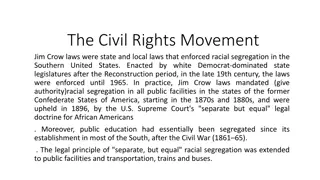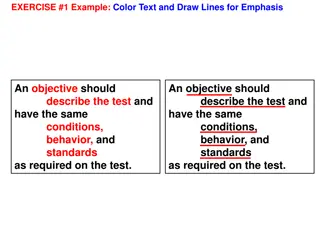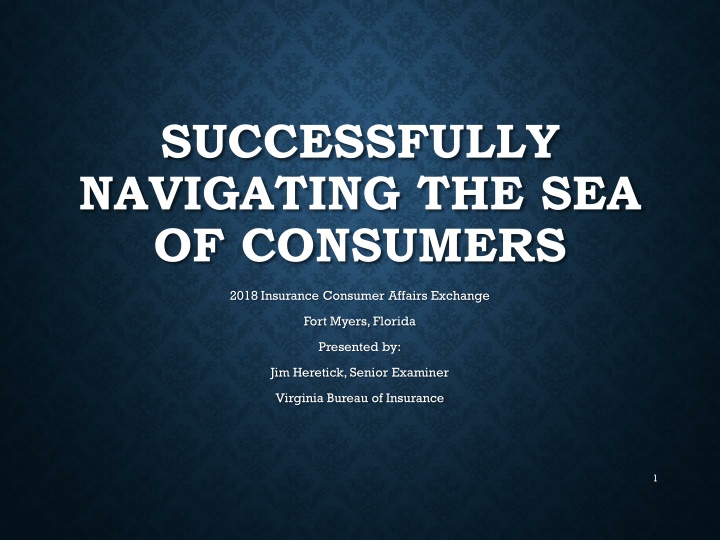
Evolution of Consumer Interactions in Insurance Industry
Explore the evolution of consumer interactions in the insurance industry over the past 20 years, from traditional complaint handling methods to changes driven by technology advancements. Discover how different generations, from the Greatest Generation to Baby Boomers, impact insurance interactions and expectations. Gain insights into adapting to consumer preferences in a digital age.
Download Presentation

Please find below an Image/Link to download the presentation.
The content on the website is provided AS IS for your information and personal use only. It may not be sold, licensed, or shared on other websites without obtaining consent from the author. If you encounter any issues during the download, it is possible that the publisher has removed the file from their server.
You are allowed to download the files provided on this website for personal or commercial use, subject to the condition that they are used lawfully. All files are the property of their respective owners.
The content on the website is provided AS IS for your information and personal use only. It may not be sold, licensed, or shared on other websites without obtaining consent from the author.
E N D
Presentation Transcript
SUCCESSFULLY NAVIGATING THE SEA OF CONSUMERS 2018 Insurance Consumer Affairs Exchange Fort Myers, Florida Presented by: Jim Heretick, Senior Examiner Virginia Bureau of Insurance 1
COMPLAINT HANDLING CHANGES OVER THE LAST 20 YEARS 20 years ago, most consumer complaints arrived by phone, mail and fax. From complaint arrival to closing letter could take from 4 to 8 weeks to get a response to the consumer. A majority of complainants understood the length of time necessary for resolution due to the use of mail. 2
COMPLAINT HANDLING CHANGES OVER THE LAST 20 YEARS, CONTINUED While computers were in use, many companies and regulators were still using Windows 3.11. Word processing software was in its infancy, Microsoft Word, Word Perfect, and Word Star were in use. Complaint tracking software was typically based on mainframe systems, i.e. Unix. 3
CONSUMER EXPECTATIONS 20 YEARS AGO Consumers were still typically purchasing their insurance polices from their local neighborhood agent. However, insurance sales were at a crossroads. Busy consumers did not want to have to visit their agent to buy insurance. Newer companies were coming into the market using an 800 number, not local agents. In response to consumers wanting to be able to contact the company 24/7, 800 numbers became commonplace. With the growth of the internet, company and regulator websites appeared as more consumers became computer savvy. Policies were still mailed to the consumer. Consumers dealt with local claims offices. 4
KNOW YOUR CONSUMER: HOW DIFFERENT GENERATIONS AFFECT YOUR INTERACTIONS The Greatest Generation Grew up in the Depression and with WWII. Absence of technology until very late in life. Desire to do business in person, face to face. Wants responses in writing, hard copy of policy. Prefers a local agent or a single point of contact when insurance questions arise. Tries to thoroughly understand insurance and will ask numerous questions. 5
KNOW YOUR CONSUMER: HOW DIFFERENT GENERATIONS AFFECT YOUR INTERACTIONS, CONTINUED Baby Boomers Children of the Greatest Generation. Grew up in a more affluent economy. Want to make sure that they are fully covered. Like to have a local agent, but willing to explore other insurance delivery options. Expect the agent and company to ensure no/few gaps in coverage. Very aware of the cost of insurance and expect something for the premiums paid. 6
KNOW YOUR CONSUMER: HOW DIFFERENT GENERATIONS AFFECT YOUR INTERACTIONS, CONTINUED Generation X First generation with home computers. Grew up with rapid technological change and innovation, i.e. Moore s Law. Recession in the 80 s impacted job availability. Advent of the internet, and cell phones started to play a role in communication. Want to know the why of insurance: cost, coverage, and claims. Wants to get the best coverage for their premium dollars. Flexible with insurance delivery, local agent, via phone, or internet. 7
KNOW YOUR CONSUMER: HOW DIFFERENT GENERATIONS AFFECT YOUR INTERACTIONS, CONTINUED Millennials Children of both Baby Boomers and Generation X: Raised under very different parenting styles. Exposed to technology at a very early age; embraces and adopts new technology quickly. Connected 24/7; uses technology to access information continuously. Prefers to use technology for interactions involving insurance: purchasing, making coverage changes, payment, and claims handling. Expects quicker responses to their inquiries due to the use of technology. 8
EDUCATING OUR CONSUMERS: HOW WE CAN INFLUENCE EXPECTATIONS AND BEHAVIORS Knowledge is your best policy. How can we educate consumers so that they understand their policies? Educational methods: Agents and Customer Service Representatives. The policy, and accompanying policy overview pamphlets. Company and Regulator websites; especially with a Frequently Asked Questions (FAQ) section. 9
EDUCATING OUR CONSUMERS: HOW WE CAN INFLUENCE EXPECTATIONS AND BEHAVIORS, CONTINUED Cell Phone Apps Policy forms, make payments, insurance cards. Online chat. Report claims. Submit photos of damage, scene of accident. Submit claim documents. 10
RESPONDING TO CONSUMER COMPLAINTS: AN OPPORTUNITY TO CALM STORMY SEAS Most frequent property and casualty complaints Claims Handling Unsatisfactory settlement offer. Delays in handling claim. Claim denial or no coverage in force for the loss. Policy Premium Rate Increases. Use of credit in underwriting. Premium refunds. Coverage Questions Change in deductible. Availability of endorsements. Exclusions and limitation on coverage. 11
RESPONDING TO CONSUMER COMPLAINTS: AN OPPORTUNITY TO CALM STORMY SEAS, CONTINUED Most frequent Life and Health complaints Claim Handling Claim denials and delays in handling claims Life Insurance: 2 year contestability clause. Policy declared null and void from inception due to false or misleading information during the application process. Claims not paid as expected by the insured The insured has not read or understood the provisions of the policy. Questions on coverage not arising until bills from medical providers arrive. Premiums Increases Significant number of inquiries due to large rate increases. Coverage Questions What does my policy cover Universal Life: Why do premiums increase, not understanding how the policy performs, possibility of policy lapse due to cash value / accumulations not enough to cover premiums. Annuities: Claims of misrepresentation by agent due to insured not reading the contract or understanding the terms of the contract; how it performs and how benefits are paid. 12
SPECIAL POPULATIONS: PROVIDING A LIFEBOAT FOR THOSE IN NEED Identifying consumers that need a helping hand understanding insurance products Education level Age Health of consumer. Assisting those with disabilities. Socio-economic status (SES) What percentage of income is available for insurance? English as a second language (ESL) Availability of translations services. Multi-lingual employees. Educational materials in multiple languages. 13
THE DIFFICULT CONSUMER The one consumer that cannot be satisfied Still unsatisfied after both company and regulator have reached the limits of their authority. Consumer has sent numerous letters and e-mails to companies and regulators, as well as placed many, many phone calls to both without what they believe is a satisfactory resolution. Many times, the issues at hand can only be resolved in court. Consumer may not have the money available to hire an attorney. Consumer may become abusive. Inappropriate language may become part of their interactions with companies and regulators. 14
SOLUTIONS FOR DIFFICULT CONSUMERS Let them vent Let them get it all out. Be a good listener. Keep your voice level when responding. Reiterate what you have done to assist them Re-visit the original complaint and explain what happened, why it happened, and what resolutions were presented. If available, provide options Escalate the problem up the chain of command. If the court system is the only available option, tell them why. Last resort If personnel safety concerns arise, contact your General Counsel for guidance or local law enforcement. Have General Counsel take legal actions to prevent further contact from the consumer if all other options to peacefully resolve the problem have been exhausted. 15
EDUCATIONAL STRATEGIES: KEEP IT SIMPLE! Company and Regulator Outreach Programs In person instruction Face time with consumers. Brings the human touch to interactions. Using booths or tables at community events to bring insurance awareness to consumers. Use of goodie bags with educational materials as giveaways. Connections for Consumers Special points of contact for consumers. Avoid the push this button phone tree to obtain assistance. Simplify consumer interactions with representatives. Ease consumer fears and increase consumer confidence. Educational Sources Simplified Pamphlets Break down the complex into smaller bites of information. Easy to navigate websites Consumers want to be able to easily find answers to their questions. Easy to use cell phone apps One touch connection for assistance. Ability to use live chat. Policy information and help at the consumer s fingertips. 16
SUMMARY & CONCLUSION Questions? 17
THE END 18


